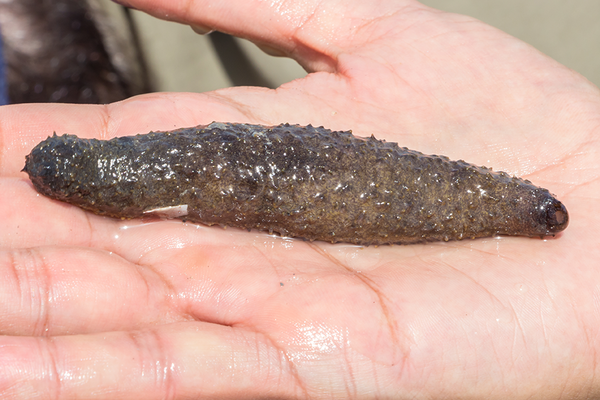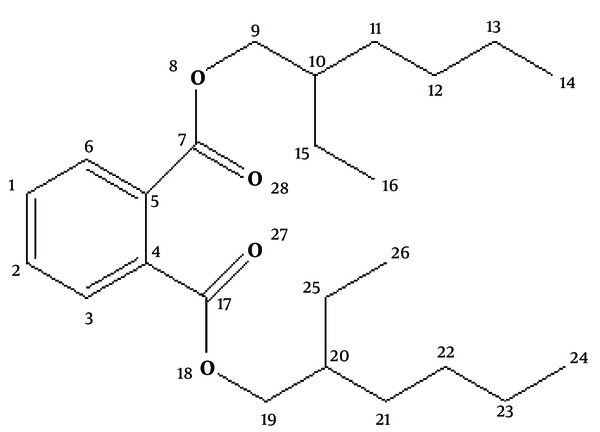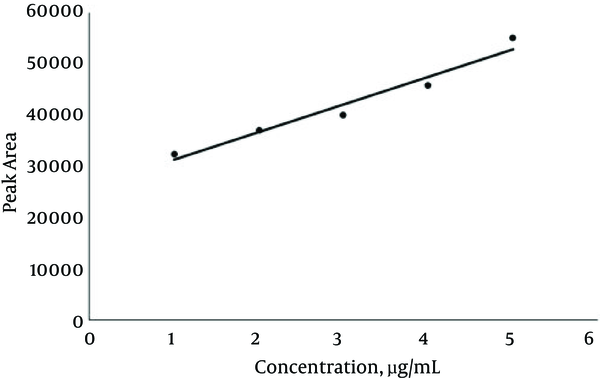Abstract
Keywords
1. Background
In the current modern society, the use of plastic material has become a critical condition with extensive uses in commercial, industrial, medicinal and other fields. Because of the free release and extensive dispose of plastic waste, it has accumulated in the environment in very high amounts. It is easily transported due to its lightweight and reaches the coasts. Therefore, this durable material has become a common element of marine habitat (1).
Recently, inconspicuous microscopic plastic particles have been identified as a universal component of marine detritus. During the last four decades, they have been increasing in oceans over the world (2).
Most commonly used phthalate esters, such as bis(2-ethylhexyl) phthalate (BEHP) and di-isononyl phthalate (DINP), are one of the main groups of plastics that may cause severe side effects for human health (3). These phthalates effect the endocrine systems, such as sex hormones and thyroids (4). Previous studies also indicate that phthalates could exhibit inflammation, early puberty in girls, oxidative stress, asthma, and allergic reactions (5-7). Furthermore, induction of toxicity in the liver, lungs, kidneys and testis has been reported for these compounds (3).
Because of microplastic accumulation in marine environments, they become in contact with deposit- and detritus-feeding organisms and may be ingested. Marine organisms, such as omnivorous amphipod Orchestia gammarellus and the deposit feeding polychaete Arenicola marina have been reported to ingest microplastic (8). Literature also reported microplastic ingestion in the benthic holothurians (sea cucumbers), Thyonella gemmate, Cucumaria frondosa, Holothuria floridana and H. grisea (9).
Sea cucumbers are echinoderms from the class Holothuroidea. They are marine organisms covered with a leathery skin and a worm-like gelatinous body with a single, branched gonad. They are found in oceans around the world. There are 1717 holothurian species worldwide that are mainly distributed in the Asia-Pacific region. Until now, 1,400 species of sea cucumbers have been identified and reported worldwide (10). Sea cucumbers are benthic animals with diverse and useful medicinal properties (11). Therefore, the isolation, structure elucidation, and screening of their bioactive compounds has received increasing attention. They are useful for their potential anti-inflammatory and anti-tumorigenic properties and also used for treatment and prevention of other human diseases, including cancers. Due to their natural origin, long history of use as food, and lack of toxic effects, these compounds are good candidates in pharmaceutical researches.
Sea cucumbers may be intermediate organisms in phthalate conversion from the marine environment to a biological media. Phthalate esters, in particular BEHP, have been detected in worldwide marine environments. Recently, their distribution in the environment and potential human health risks have been well-documented. The concentrations and distribution of phthalate esters in the marine habitat have become the focus of much attention and reported in the different countries, such as the Klang River Basin, Malaysia (12), the Rieti District, Italy (13), Urdaibai Estuary of Gernika, Spain (14), and the False Creek Harbor of Vancouver, Canada (15). The current literature highlights the importance of determining phthalate derivatives in Holothuria atra to determine the status of environmental contamination. The main purpose of the present study was to investigate the isolation, structure elucidation, and quantification of a phthalate ester in a sea cucumber from the Persian Gulf, as a marine food and medicinal resource for the first time.
2. Methods
2.1. Sample Collection and Extraction
Holothuria atra was collected from the Persian Gulf, Bushehr province, Iran during October, 2015. Identification of sea cucumber was carried out by Dr Seyyed Mohammad Bagher Nabavi from the Khoramshahr Marine Science and Technology University. The sample was identified as Holothuria atra sp. as shown in Figure 1. The animal (about 1.4 kg wet weight) was cut into pieces, dried by a freeze drier, and extracted four times with EtOAc-MeOH (1:1). The solvent was evaporated by a rotary evaporator. One milligrams of the extract was dissolved in methanol and used for quantitative analysis of BEHP in this sea cucumber and the remaining was used in the isolation pathway.
Sea cucumber Holothuria atra sp.

2.2. Isolation of Bis(2-ethylhexyl) Phthalate
The extract was partitioned to hexane, dichloromethane, butanol, and water with the Kupchan partitioning method (16). In this method, the extract was partitioned between MeOH 90% and hexane, MeOH 80% and dichloromethane, respectively. Finally, the MeOH solvent was removed completely and the remaining water was partitioned with ButOH. The hexane partition was further fractionated by MPLC. Silica gel was used as the stationary phase and the column was eluted with a gradient solvent system from 100% hexane to pure EtOAc. The eluates were monitored by TLC and 1HNMR and divided to 10 fractions (Frs. 1-10; Fr. 1 contained BEHP). Bis(2-ethylhexyl) phthalate (150 mg) was isolated by HPTLC separation (100% MeOH) and used for NMR analysis and also as a standard of quantification.
2.3. Quantification of Bis(2-ethylhexyl) phthalate in Holothuria atra
To determine the amount of BEHP, 10 mg of BEHP was dissolved in 10 mL of methanol in a volumetric flask to prepare a stock solution. The solution was diluted by two folds with the same solvent to obtain a 0.5-mg/mL concentration. A calibration plot was obtained by applying different volumes (lL) of the stock solution on the plates. Bis(2-ethylhexyl) phthalate and sample solutions were applied on the plates (silica gel 60 HF254 + 366) by means of Camag Nanomat. Samples were applied to the plates by means of disposable fine glass capillaries. The spots were dried completely and the plates were developed using of toluene + ethyl acetate (10:1, v/v), as a solvent system. After development, the plates were dried by air and detected under UV365 light inside a UV-cabinet or by iodine vapor. Bis(2-ethylhexyl) phthalate bands were scanned and quantified by a Camag TLC Scanner, operated in reflectance–absorbance mode using a deuterium lamp. The maximum absorption wavelength (280 nm) of the compound was determined by means of the UV absorption spectrum of isolated BEHP, using the spectrum mode of the scanner. The WINCATS software from Camag was used for scanner control and data processing (17).
2.4. Nuclear Magnetic Resonance Spectroscopy Analysis
The isolated compound obtained from column chromatography was analyzed for nuclear magnetic resonance spectroscopy (NMR) analysis. The 1H NMR experiments were performed on Bruker Unity 400 MHz using TMS as an internal standard. The spectra were obtained using the standard Bruker software. The observed chemical shift (δ) values were given in ppm and the coupling constants (J) in Hz. To elucidate the chemical structures of the promising active compound, it was analyzed using infrared, mass and nuclear magnetic resonance spectroscopy. The IR spectrum of the pure compound was performed with KBr pellets.
3. Results
Overall, 1.4 Kg of H. atra from the Persian Gulf was extracted with MetOH: EtOAc (1:1) and partitioned sequentially to give 0.9 g of hexane, 5 g dichloromethane, 4 g butanol, and 10 g water fractions. Hexane partition was further fractionated and isolated using column chromatography and finally yielded a pure compound. The structural elucidation was carried out by detailed interpretation of NMR, Mass and IR spectroscopic data.
The DEHP was obtained as a colorless oily liquid, which is soluble in hexane. The IR spectrum of this compound showed a characteristic peak of the carbonyl group (C = O) at 1728 cm-1(?). Other peaks appeared at 2956 cm-1 (-CH2 stretch), 2860 cm-1 (-CH3 stretch), 1464 and 742 cm-1 (methylene C-H bend and (CH2) n-rocking), respectively, and 1122 cm-1 (C-O stretch). The 1H-NMR spectrum of the compound showed aromatic protons at δ:7.71 and 7.55, two protons at δ:4.23, one proton at δ:1.43, and two methyl resonances at δ:0.95. Also, the characteristic signals of the methylene groups, and the existence of only two aromatic protons in the molecule were shown in the 1H-NMR spectrum. This suggested that the compound must have an ortho-disubstituted benzene ring bearing the same substituted in both protons. The H-NMR spectrum of the compound also confirmed the symmetry of the molecule. The molecular weight was established by GC-MS as [M+] 390. By comparison of 1H-NMR data to those published in the literature, the compound was identified as Bis(2-ethylhexyl) phthalate (BEHP) (Figure 2) (18).
Structure of bis(2-ethylhexyl) Benzene-1,2-Dicarboxylate

The isolated bis (2-ethylhexyl) benzene-1, 2-dicarboxylate was analyzed further by TLC (RF= 0.85) and used as a standard marker for quantification of BEHP pollution in the sea cucumber extract. Figure 3 shows the calibration curve of BEHP (17). The amount of BEHP in H. atra was 0.15 ± 0.08 mg/g.
Calibration Curve of bis (2-ethylhexyl) Benzene-1,2-Dicarboxylate

3.1. Bis(2-ethylhexyl) Phthalate. 1H NMR (CDCl3, 400 MHz)
δ 7.71 (2H, m, H1,2), δ 7.55 (2H, m, H3,6), δ 4.23 (4H, m, 11, 5.6 Hz, H9,19), δ 1.72 (2H,m, H10,20), δ 1.46 (4H, m, H11,21), δ 1.40 (4H, m, H13,23), δ 1.36 (8H, m, H12,22,15,25), δ 0.96 (6H, t, 6.3 Hz, H14,24), δ 0.94(6H, t, 5.0 Hz, H16,26)
4. Discussion
Currently, isolating bioactive compounds from natural food sources for producing pharmaceutical agents has become the focus of attention. Bioactive compounds found in marine organisms, such as seaweeds, soft corals, sponges, mollusks, phytoplanktons, tunicates, echinoderms, and bacteria have shown wide variety of applications in medicinal fields (19, 20). Holothurians have been used for centuries as an anti-inflammatory and anti-disease food source and for treating different ailments in South East Asian countries, such as Korea, Japan, Indonesia, and China (21, 22). They are nutrient-rich invertebrates, similar to cucumber with a leathery skin and gelatinous body (23).
More than 50 years ago, production of plastics in the environment was started and currently these durable compounds are widespread all over the planet. From the literature, it is obvious that holothurians ingest plastic in different shapes and sizes. Besides, sea cucumbers are a useful model for studying plastic ingestion in deposit-feeding organisms (9). In fact, considered non-selective feeders ingest high amounts of sediment into their mouths for extracting nutrition from biofilms, organic debris, and microorganisms. It is estimated that deposit-feeding holothurians around Lizard Island, Australia, ingest the top 5.0 mm of sediments each year in a 1000 m2 area, an average daily volume exceeding 8.3 × 106 m3 (24). Currently, there is a lack of studies on bioaccumulation of plastics in marine environments. Since invertebrates accumulate microplastics, they are likely to transport them to the food web. No previous study has studied the amounts of plastic found in Holothuria atra, as a biomarker of the level of pollutant in the Persian Gulf, yet different researches have incidentally noted the presence of these toxic compounds in other marine vertebrate and invertebrate samples in different coastal areas. Lusher et al. found microplastics in 36.5% of fish belonging to 10 species sampled from the English Channel, irrespective of habitat (25). Adebola et al. analyzed fish samples as a biomarker of pollutant in a river from Nigeria and phthalate level was reported to be 181 µg/g (24). Other studies demonstrate that field-collected marine invertebrates contain microplastics. Mytilus edulis and Arenicola marina contained on average 0.2 ± 0.3 and 1.2 ± 2.8 particles per gram of tissue, respectively (26). In two other papers, microplastics were detected in wild and aquaculture populations of M. edulis and Crassostrea gigas (27, 28). Various factors affect the ingestion of microplastics by a marine organisms. Particle size seems to be an effective factor to determine whether a plastic will be ingested and also the number of particles that will be ingested. The literature has reported that Holothuria grisea sea cucumbers ingested the highest amount of plastic and sand (9), yet if the particles are small enough, other aspidochirotid and dendrochirotid species would be able to fit them in their mouth and ingest plastic particles. When sea cucumber tentacles come in contact with a particle, if the plastics are comparable in size to other readily ingested sediments, the particle will be pulled from the sediment, and transported to the mouth. In addition, the amount of microplastics ingested is dependent of the type of invertebrates. For example, Thyonella gemmata sea cucumbers ingested approximately 17 times more plastic than expected (29). The current results demonstrate that H. atra of Persian Gulf coasts of Iran contains high quantity of DEHP as a marker of pollutant in this region. It is suggested to analyze other species of Holothuria from different regions of the Persian Gulf and quantify their phthalate compounds to compare plastic pollution in this area. Sea cucumber extracts are interesting candidates with a promising future to be used as functional foods. These extracts could be potential candidates for the prevention and treatment of disease such as cancers but individual agent analysis must be performed to determine microplastic concentrations for their use in pharmaceutical or food industries. On the other hand, using ecosystems containing this animal and even increasing their amount may result in a decrease in the plasticizers in the environment that will be advantageous for other organisms living in the area.
Acknowledgements
References
-
1.
Moore CJ. Synthetic polymers in the marine environment: a rapidly increasing, long-term threat. Environ Res. 2008;108(2):131-9. [PubMed ID: 18949831].
-
2.
Carpenter EJ, Anderson SJ, Harvey GR, Miklas HP, Peck BB. Polystyrene spherules in coastal waters. Science. 1972;178(4062):749-50. [PubMed ID: 4628343].
-
3.
Manayi A, Kurepaz Mahmoodabadi M, Gohari AR, Ajani Y, Saeidnia S. Presence of phthalate derivatives in the essential oils of a medicinal plant Achillea tenuifolia. Daru. 2014;22(1):78. [PubMed ID: 25429772]. https://doi.org/10.1186/s40199-014-0078-1.
-
4.
Meeker JD, Ferguson KK. Phthalates, human exposure and related health effects. In: Schecter A, editor. Dioxins and health, including other persistent organic pollutants and endocrine disruptors. 3 ed. Hoboken: John Wiley and Sons; 2012. p. 415-43.
-
5.
Jaakkola JJ, Knight TL. The role of exposure to phthalates from polyvinyl chloride products in the development of asthma and allergies: a systematic review and meta-analysis. Environ Health Perspect. 2008;116(7):845-53. [PubMed ID: 18629304]. https://doi.org/10.1289/ehp.10846.
-
6.
Ferguson KK, Cantonwine DE, Rivera-Gonzalez LO, Loch-Caruso R, Mukherjee B, Anzalota Del Toro LV, et al. Urinary phthalate metabolite associations with biomarkers of inflammation and oxidative stress across pregnancy in Puerto Rico. Environ Sci Technol. 2014;48(12):7018-25. [PubMed ID: 24845688]. https://doi.org/10.1021/es502076j.
-
7.
Swan SH. Environmental phthalate exposure in relation to reproductive outcomes and other health endpoints in humans. Environ Res. 2008;108(2):177-84. [PubMed ID: 18949837].
-
8.
Murray F, Cowie PR. Plastic contamination in the decapod crustacean Nephrops norvegicus, (Linnaeus, 1758). Mar Pollut Bull. 2011;62(6):1207-17. [PubMed ID: 21497854]. https://doi.org/10.1016/j.marpolbul.2011.03.032.
-
9.
Graham ER, Thompson JT. Deposit and suspension feeding sea cucumbers, (Echinodermata) ingest plastic fragments. J Exp Mar Bio Ecol. 2009;368(1):22-9. https://doi.org/10.1016/j.jembe.2008.09.007.
-
10.
Conand C. Present status of world sea cucumber resources and utilisation, an international overview. In: Conand C, editor. Advances in sea cucumber aquaculture and management. Rome, Italy: FAO Fisheries Department; 2004.
-
11.
Mamelona J, Pelletier E, Girard Lalancette K, Legault J, Karboune S, Kermasha S. Quantification of phenolic contents and antioxidant capacity of Atlantic sea cucumber, Cucumaria frondosa. Food Chem. 2007;104(3):1040-7. https://doi.org/10.1016/j.foodchem.2007.01.016.
-
12.
Tan GH. Residue levels of phthalate esters in water and sediment samples from the Klang River basin. Bull Environ Contam Toxicol. 1995;54(2):171-6. [PubMed ID: 7742623].
-
13.
Vitali M. Phthalate esters in freshwaters as markers of contamination sources a site study in Italy. Environ Int. 1997;23(3):337-47. https://doi.org/10.1016/s0160-4120(97)00035-4.
-
14.
Bartolome L, Cortazar E, Raposo JC, Usobiaga A, Zuloaga O, Etxebarria N, et al. Simultaneous microwave-assisted extraction of polycyclic aromatic hydrocarbons, polychlorinated biphenyls, phthalate esters and nonylphenols in sediments. J Chromatogr A. 2005;1068(2):229-36. [PubMed ID: 15830928].
-
15.
Mackintosh CE, Maldonado JA, Ikonomou MG, Gobas FAP. Sorption of phthalate esters and PCBs in a marine ecosystem. Environ Sci Technol. 2006;40(11):3481-8. https://doi.org/10.1021/es0519637.
-
16.
Van Wagenen BC, Larsen R, Cardellina JH, Randazzo D, Lidert ZC, Swithenbank C. Ulosantoin, a potent insecticide from the sponge Ulosa ruetzleri. J Org Chem. 1993;58(2):335-7. https://doi.org/10.1021/jo00054a013.
-
17.
Mirzaie A, Jamshidi A, Waqif Husain S. Fast chromatographic separation of plasticizers on thin layers of an inorganic ion-exchanger: Quantitative determination of Di, (2-ethylhexyl) phthalate. Chromatographia. 2007;65(3-4):245-8. https://doi.org/10.1365/s10337-006-0143-0.
-
18.
El Sayed OH, Asker MM, Shash SM, Hamed SR. Isolation, structure elucidation and biological activity of Di, (2-ethylhexyl) phthalate produced by penicillium janthinellum 62. Int J ChemTech Res. 2015;8(1):58-66.
-
19.
Shushizadeh MR. Persian Gulf bioactive natural drugs. Jundishapur J Nat Pharm Prod. 2014;9(2):19354. https://doi.org/10.17795/jjnpp-19354.
-
20.
Ameri A. Marine microbial natural products. Jundishapur J Nat Pharm Prod. 2014;9(4):24716. [PubMed ID: 25625055].
-
21.
Aydın M, Sevgili H, Tufan B, Emre Y, Kose S. Proximate composition and fatty acid profile of three different fresh and dried commercial sea cucumbers from Turkey. Int J Food Sci Technol. 2011;46(3):500-8. https://doi.org/10.1111/j.1365-2621.2010.02512.x.
-
22.
Conand C, Byrne M. A review of recent developments in the world sea cucumber fisheries. Oceanograph Lit Rev. 1995;7(42):570.
-
23.
Weiss KR, Mc Farling U, Loomis R. Tentacular diversity in deep sea deposit feeding holothurians, Implications for biodiversity in the deep sea. Los Angeles Times. 2006;2.
-
24.
Roberts D, Moore H. Tentacular diversity in deep sea deposit feeding holothurians, Implications for biodiversity in the deep sea. Oceanograph Lit Rev. 1998;6(45):994.
-
25.
Lusher AL, McHugh M, Thompson RC. Occurrence of microplastics in the gastrointestinal tract of pelagic and demersal fish from the English Channel. Mar Pollut Bull. 2013;67(1-2):94-9. [PubMed ID: 23273934]. https://doi.org/10.1016/j.marpolbul.2012.11.028.
-
26.
Van Cauwenberghe L, Claessens M, Vandegehuchte MB, Janssen CR. Microplastics are taken up by mussels (Mytilus edulis) and lugworms (Arenicola marina) living in natural habitats. Environ Pollut. 2015;199:10-7. [PubMed ID: 25617854]. https://doi.org/10.1016/j.envpol.2015.01.008.
-
27.
Mathalon A, Hill P. Microplastic fibers in the intertidal ecosystem surrounding Halifax Harbor, Nova Scotia. Mar Pollut Bull. 2014;81(1):69-79. [PubMed ID: 24650540]. https://doi.org/10.1016/j.marpolbul.2014.02.018.
-
28.
Van Cauwenberghe L, Janssen CR. Microplastics in bivalves cultured for human consumption. Environ Pollut. 2014;193:65-70. [PubMed ID: 25005888]. https://doi.org/10.1016/j.envpol.2014.06.010.
-
29.
Wright SL, Thompson RC, Galloway TS. The physical impacts of microplastics on marine organisms: a review. Environ Pollut. 2013;178:483-92. [PubMed ID: 23545014]. https://doi.org/10.1016/j.envpol.2013.02.031.
